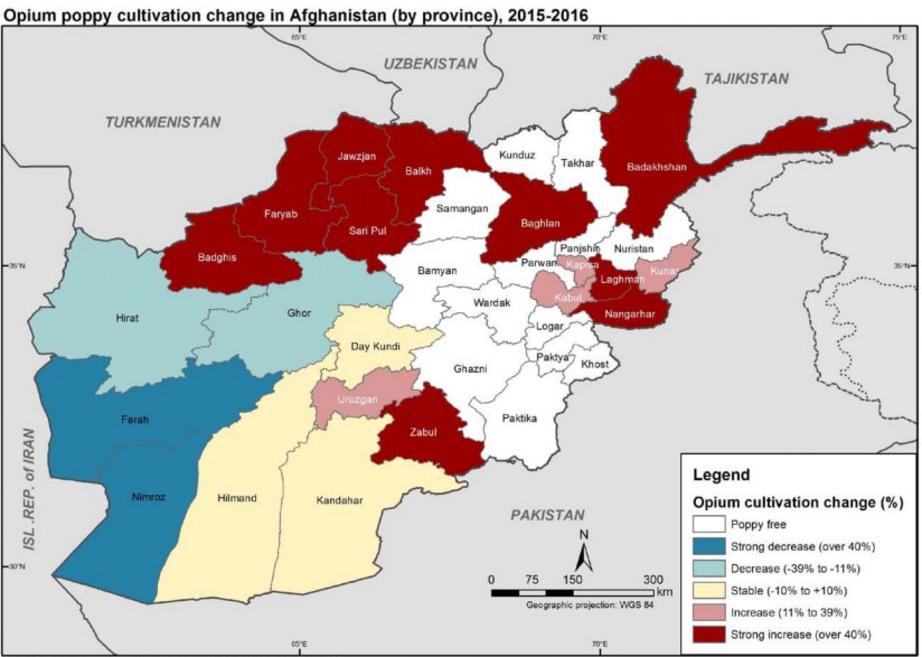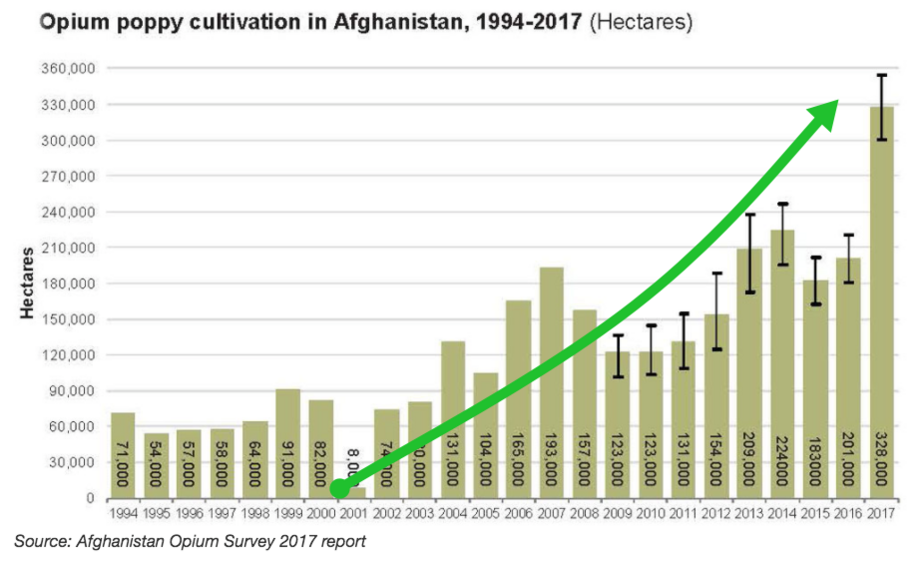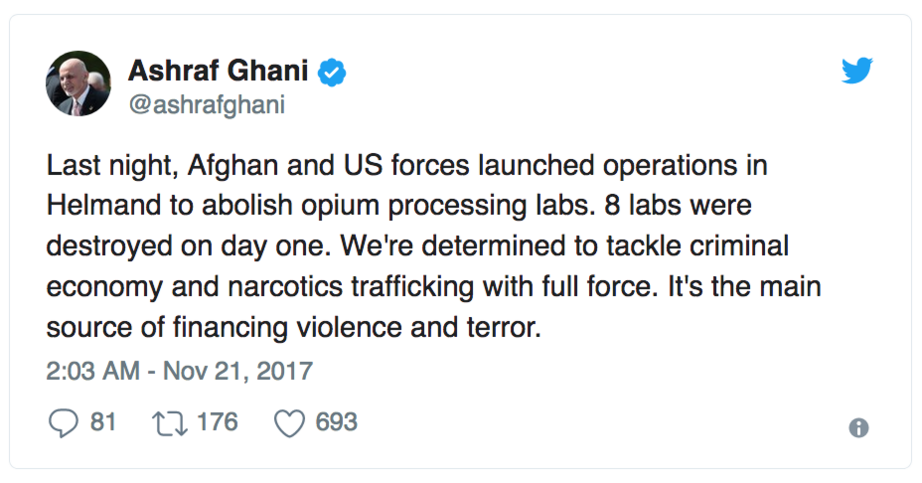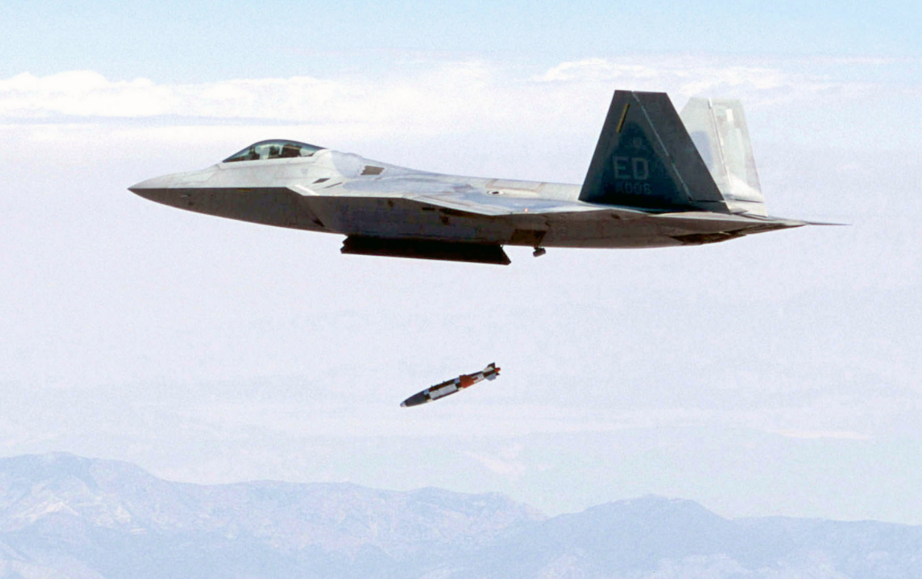Afghan war intensifies
... US stealth fighters target narcotics production facilities
16-years after the Bush administration began military operations in Afghanistan, President Trump has just launched a military campaign of his own using high-tech stealth fighters to bomb drug labs in the country.
The Pentagon’s playbook of nation building in the Middle East has stretched, now, to three Presidents making it the longest war in U.S. history. Ever since the U.S. started occupying the country in the early 2000s, opium production soared. Afghan President Ashraf Ghani said without drugs, the war in Afghanistan “would have been long over.”
In 2017, Afghanistan’s opium crop and production both hit a record high, despite the increased efforts by government to stop the drug trade. For the Taliban and other criminal elements in the region, opium is an important revenue source to fund operations.
On Monday, the Defense Department said it unleashed F-22 Raptor stealth fighters to bomb narcotic production facilities in southern Afghanistan targeting the revenue streams of the Taliban. The air operation started on Sunday and continued through Monday. The F-22s were accompanied by B-52 bombers and Afghan A-29 Super Tucanos for additional support to expand the strike mission.
According to the Washington Post,
This represents the first significant use of new legal authorities granted by the Trump administration in August that enable the Pentagon to target Taliban revenue streams, said Army Gen. John W. Nicholson Jr., the top U.S. commander in Afghanistan.
Previously, the U.S. military conducted strikes only when facing imminent threat or working directly with the Afghans.
Nicholson said, the F-22 “was used because of its ability to deliver precision munitions — in this case, a 250-pound bomb, small-diameter, that causes the minimal amount of collateral damage.” The objective for more precise munitions comes at a time where civilian deaths in U.S. airstrikes have been heavily scrutinized. Earlier this month, U.S. airstrikes in the region killed ‘at least 13 civilians’ in a bombing raid.
“This target was also a Taliban narcotics production facility in Musa Qala. So I want to draw your attention — as you look at this strike, you’re going to see that inside this compound are multiple structures, and we destroy only two of them, while leaving the third standing, which we do to avoid collateral damage,” Nicholson said.
The Drug Enforcement Administration estimates there are 400 to 500 narcotic production facilities across Afghanistan. In the latest strike about 10 of them were taken out. The concentration of strikes resided in the Helmand province, an area where Taliban hold strong control.
Opium cultivation change in Afghanistan 2015/2016 shown on the chart below indicates a rapid increase in the northern tier of the country.

More details of the operation per The Washington Post,
The strikes Sunday hit seven Taliban drug laboratories and a headquarters in three districts across northern Helmand. Three occurred in Kajaki district, four in Musa Qala and one in Sangin — all areas controlled by the U.S. military at the height of Obama’s troop surge there. The largest, carried out by a B-52, struck a opium-processing facility where 50 barrels of drugs were cooking at the time, Nicholson said. Video released by the Pentagon shows the building being consumed by a massive fireball.
The U.S. government has pursued various anti-drug strategies during its 16-year war in Afghanistan, but it has done little to hamper the steady resurgence of opium poppy cultivation and drug trafficking since the Taliban’s fall in 2001. While in power before the U.S. invasion, the Taliban banned poppy growing as un-Islamic and staged bonfires of confiscated opium and heroin.
Until now, though, those U.S. efforts have not directly involved the military. During the early post-Taliban years, the Pentagon focused exclusively on pursuing al-Qaeda and Taliban insurgents and expressly avoided diverting efforts toward curbing the drug trade. In some cases, this was because of U.S. alliances with warlords or regional strongmen who were involved in drugs.
Later, as both poppy production and drug trading rebounded, the U.S. launched several ambitious programs to counter them. One was a crop substitution campaign that encouraged and paid farmers to grow almonds, apricots, green vegetables and saffron instead of poppy. Another paid farmers cash to destroy their poppy fields and funded interdiction campaigns in which Afghan security forces burned fields under cultivation.
These efforts were fatally hampered by a mix of factors, including the enormous appeal of drug profits, the long-accepted tradition of poppy growing by small farmers, the involvement of powerful Afghans in the trade, local hostility to interdiction, and the hardiness that enabled poppy plants to thrive in harsh and dry conditions.
Meanwhile, the Taliban insurgents, apparently abandoning their previous religious scruples, became increasingly involved in both poppy cultivation and drug trafficking as a means of supporting the war, especially in Helmand province. At first they primarily demanded taxes from growers, but gradually the overlap between Taliban recruits and local agricultural labor became so pronounced that the insurgents essentially suspended military operations during poppy harvest seasons.
In the latest figures from the United Nations, “Afghanistan opium production jumps 87 per cent to record level”… Most of the increase has occurred under the United States occupation of the region.

It seems as Afghan President Ashraf Ghani is bullish on President Trump’s new campaign to bomb the nation’s narcotic facilities...

Perhaps in a preview of things to come, Sunday through Monday’s U.S airstrikes in Afghanistan signal the war is about to intensify.
Stealth fighters and other support aircraft only managed to knockout 10 narcotic facilities and as the report states there are about another 400-500 to go.

